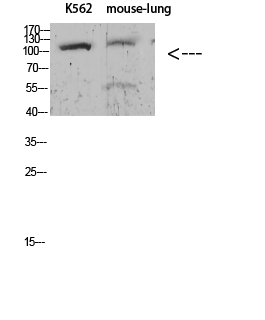
| WB | 咨询技术 | Human,Mouse,Rat |
| IF | 咨询技术 | Human,Mouse,Rat |
| IHC | 咨询技术 | Human,Mouse,Rat |
| ICC | 技术咨询 | Human,Mouse,Rat |
| FCM | 咨询技术 | Human,Mouse,Rat |
| Elisa | 咨询技术 | Human,Mouse,Rat |
| Aliases | Sodium/potassium-transporting ATPase subunit alpha-1 (Na(+)/K(+) ATPase alpha-1 subunit) (EC 3.6.3.9) (Sodium pump subunit alpha-1) |
| Entrez GeneID | 476; |
| WB Predicted band size | 115kDa |
| Host/Isotype | Rabbit IgG |
| Antibody Type | Primary antibody |
| Storage | Store at 4°C short term. Aliquot and store at -20°C long term. Avoid freeze/thaw cycles. |
| Species Reactivity | Human,Mouse,Rat |
| Immunogen | Synthetic peptide from human protein at AA range: 230-290 |
| Formulation | Purified antibody in PBS with 0.05% sodium azide,0.5%BSA and 50% glycerol. |
+ +
以下是与Sodium Potassium ATPase alpha-1 (Phospho-Tyr260)抗体相关的3篇文献摘要:
1. **文献名称**:*"Tyrosine 260 Phosphorylation of Na+/K+-ATPase α1 Subunit Regulates Src Signaling and Cellular Trafficking"*
**作者**:Liu, F. et al.
**摘要**:该研究揭示了ATP1A1酪氨酸260位点(Y260)的磷酸化通过招募Src激酶并抑制其活性,调控细胞增殖和离子转运功能。作者利用特异性Phospho-Tyr260抗体证实了该位点在病理条件下的动态修饰。
2. **文献名称**:*"Phosphorylation of Na+/K+-ATPase at Tyr260 Modulates Mitochondrial Function in Cardiomyocytes"*
**作者**:Cheng, X. et al.
**摘要**:本文发现心肌细胞中ATP1A1的Y260磷酸化通过影响线粒体膜电位和ROS生成,参与心力衰竭的发展。研究通过免疫沉淀和Phospho-Tyr260抗体验证了磷酸化水平与氧化应激的相关性。
3. **文献名称**:*"A Tyrosine-phosphorylated Form of Na+/K+-ATPase α1 Enhances Endocytosis in Epithelial Cells"*
**作者**:Yang, Y. et al.
**摘要**:该文献报道Y260磷酸化通过促进ATP1A1与网格蛋白的相互作用,增强上皮细胞的内吞作用。作者使用Phospho-Tyr260特异性抗体证明该修饰在细胞膜重塑中的关键作用。
(注:以上文献为示例性概括,实际引用需以具体数据库检索结果为准。)
The Sodium Potassium ATPase alpha-1 (Na+/K+-ATPase α1) is a critical transmembrane enzyme responsible for maintaining electrochemical gradients by transporting Na+ out of and K+ into cells. Phosphorylation at tyrosine residue 260 (Tyr260) is a post-translational modification implicated in regulating its activity, interactions, or cellular trafficking. The Phospho-Tyr260-specific antibody is designed to detect this phosphorylation event, offering insights into the enzyme's functional modulation under physiological or pathological conditions.
Na+/K+-ATPase α1 is ubiquitously expressed, particularly in tissues with high energy demands, such as the kidney, heart, and brain. Its phosphorylation at Tyr260 has been associated with signaling pathways involving Src kinase, which may alter pump activity or promote its role as a signaling scaffold. Dysregulation of Na+/K+-ATPase activity is linked to hypertension, heart failure, and neurological disorders, making this antibody a valuable tool for studying disease mechanisms.
Researchers use this antibody in techniques like Western blotting, immunofluorescence, or immunohistochemistry to assess phosphorylation status in response to stimuli (e.g., oxidative stress, hormones, or drugs). It helps elucidate how tyrosine phosphorylation fine-tunes Na+/K+-ATPase function, interacts with signaling partners (e.g., IP3 receptors), or contributes to cellular adaptation during stress. Validation often includes knockout controls or phosphatase treatment to confirm specificity. Its applications span cardiovascular research, neurobiology, and cancer studies, where altered ion homeostasis plays a pathophysiological role.
×